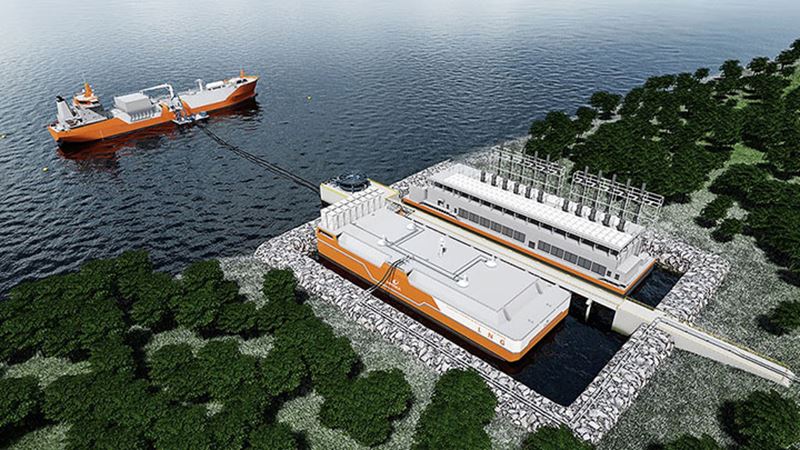Revolutionary transfers

The Liquefied Natural Gas (LNG) market is growing globally. In particular, the shift from large land-based terminals to a more agile and scalable model for LNG transfer will boost the market as the needs of regions that have energy infrastructure challenges can now be met.
Wärtsilä set out to design a solution that would enable small- and mid-scale LNG deliveries to locations with no existing LNG infrastructure. These include areas where the water is too shallow for ships or a jetty, or where a jetty is otherwise impractical. The concept should also allow operations in environmentally sensitive areas.
“Wärtsilä wanted to provide reliable, complete, turnkey solutions for these kinds of requirements,” says Kenneth Engblom, Wärtsilä’s Director, Global Sales & Marketing, LNG Infrastructure and Energy Solutions. “There are countless sites around the world where traditional harbors and jetties are unfeasible. Our jettyless solution is perfectly suited to difficult or environmentally sensitive locations.”
In Wärtsilä’s solution, the jetty is replaced by a selfpropelled Floating Transfer Terminal (FTT) that is connected with a shore facility through Trelleborg’s Cryoline
floating hose. The terminal can travel as far as 500 meters offshore. The FTT has been developed in cooperation with the marine engineering firm Houlder and Klaw.
Wärtsilä first approached Trelleborg with the idea of a jettyless LNG terminal at the end of 2016 with a request for a floating transfer hose suitable for LNG.
“We needed a solution that would replace the traditional jetty,” Engblom says. “The solution should be cheaper than a traditional jetty, and it had to give the confidence to investors and banks that it is a proven and reliable solution. Trelleborg is an innovator in its field, and with a partner like that we felt confident to go forward. The company is well known for its high standards in its products and documentation, which made it a logical partner in our venture. And it helps that its corporate values are very similar to ours.”
Gas in its liquefied form presents a challenge as it needs to be transported at a temperature of -163 °C. It requires specialized hosing to transfer, and floating hoses to cover stretches of water. With Trelleborg’s floating cryogenic hoses, vessels can be moored as far as 300 to 500 meters away from an onshore storage unit. Besides the ship-to-shore connection, the hose also allows for ship-to-ship transfer in deeper waters and will be much more forgiving and flexible than a fixed loading/unloading arm.
Trelleborg’s hoses are available with large inner diameters ranging from 6 to 20 inches, allowing them to cope with an LNG transfer flow rate of up to 10,000 cubic meters per hour. When not in use, the hoses are stored onshore on a custom-designed reel system.
“Our Cryoline hose enables us to rethink lng transfers from vessel to shore,” says Vincent Lagarrigue, Oil & Marine Director within Trelleborg Industrial Solutions.
“The jettyless solution is cost-effective, quick to deploy and friendly to the environment. We are fortunate to have a partner like Wärtsilä. Our cooperation is a true win-win situation.”
Engblom adds, “Cryoline’s technology has been a key component for the jettyless concept. One of the keys was that the technology is certified and qualified globally.”
Engblom and Lagarrigue agree that jettyless LNG terminals will be in high demand in the near future, and they are already seeing this in the interest generated by the concept.
Trelleborg Cryoline LNG Floating Hose
- Hose-in-hose design with insulation
- Sizes 6 to 20 inches (inner diameter)
- EN 1474-2 Certified Technology
- Maximum allowable operating pressure 20 bar
- Integrated leak monitoring system
- For wave heights up to 5.5 meters.
In addition to Trelleborg’s hoses, Trelleborg is a world leader in Ship-Shore Link (SSL) and Emergency Shut-Down (ESD) technology for the LNG industry. From LNG carriers, Floating Storage Re-gasification Units (FSRUs) to LNG terminals the Trelleborg system has been an industry standard for nearly 20 years.
For more information, please go to:
www.trelleborg.com/en/fluidhandling/
This is an article has been reproduced from Trelleborg's T-Time magazine. To download the latest edition, go to: www.trelleborg.com/t-time
Press Service: This article is available in eight languages. Media are welcome to use this article in their own publications. To download the article and pictures in any language go to https://bamboo-contentpartner.com/. If you reproduce information from this release, please give contact details as: www.trelleborg.com.